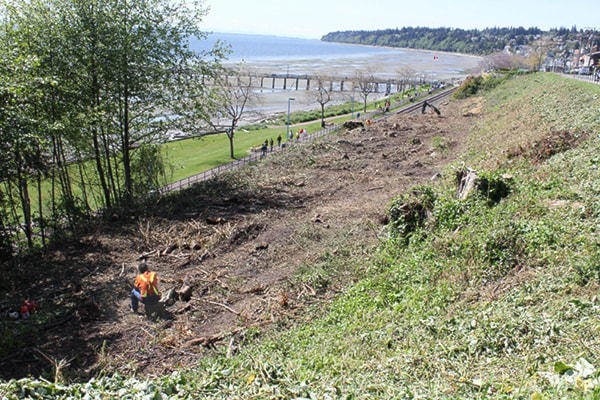Several White Rock residents were surprised to find crews removing trees and other vegetation on the waterfront this week, as part of a city-contracted project aimed at “maintaining slope stability.”
Peace Arch News received several phone calls earlier this week from residents concerned about work taking place on the bluff.
“I’m upset, to say the least,” said John Edwards, a Marine Drive resident who said he went to city hall for an explanation but still was not clear on why trees and other plants were being removed.
A notice on the city’s website May 4 and signs along the railway fencing state that crews would be removing vegetation from the “White Rock pier to Johnston Street.”
“The work will focus on maintaining slope stability, increasing line of sight and eradicating invasive species,” the notice states.
White Rock Coun. David Chesney, however, said Wednesday that he was “shocked” to see trees removed from the hillside, adding that improving residents’ waterfront views played a role in the decision.
“Some people that have friends are getting their views improved dramatically, and that’s the sole reason these trees are coming down,” Chesney said, noting he plans on lodging a formal complaint with Burlington Northern Santa Fe next week.
The city’s director of engineering and municipal services, Greg St. Louis, told PAN the work was part of a capital project presented to the public earlier this year.
“It’s vegetation removal, mostly brush, and there are some non-protected trees there as well,” he said, noting the city was working with BNSF, which owns the land, and that some of the trees being removed are meant to improve the railway’s line of sight for the pier crossing.
A BNSF spokesperson confirmed Wednesday that one specific tree “interferes with the safe operation of the railroad.”
“What I’ve been told by the city is that they’re not taking large trees out,” Gus Melonas said. “They’re controlling the vegetation, brush, shrubbery and smaller scrub-type trees.”
The work will also focus on removal of invasive plants, such as blackberry bushes, which are a problem on the hillside, St. Louis said, noting such vegetation has shallow roots.
 “We’re going to replant with better plants that will help promote the stability and beautify the hillside,” St. Louis said, noting replanting should be finished by July.
“We’re going to replant with better plants that will help promote the stability and beautify the hillside,” St. Louis said, noting replanting should be finished by July.
When asked if vegetation removal was meant to improve the views for residents living on Marine Drive, St. Louis said, “I’m sure that was part of the decision, but the main driving force was slope stability.”
However, Chesney, who was first elected last November, said it is “ridiculous” that the city would embark on such work – which was approved at a cost of $80,000 for 2015 – given the history of slides along the railway line.
“The amount of slides we have on average every year, it’s only a matter of time before one of those trains goes off the tracks,” he said. “I don’t want to scare people, that’s not what I’m trying to do, I’m just saying the city should be erring on the side of safety, instead of simply trying to improve the view of a couple dozen of their friends.”
Chesney has long opposed tree removal on the hump. In 2008, he climbed a tree in an attempt to stop crews from carrying out trimming efforts on the hillside. As a result of that protest by Chesney – along with Don Pitcairn and then-councillor James Coleridge – the work to trim trees was delayed 18 months.
